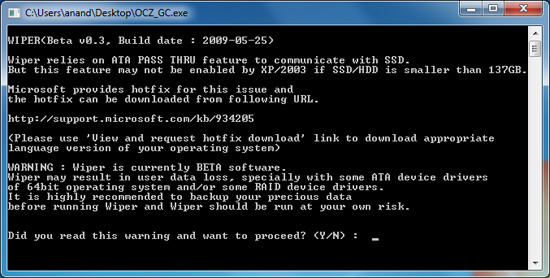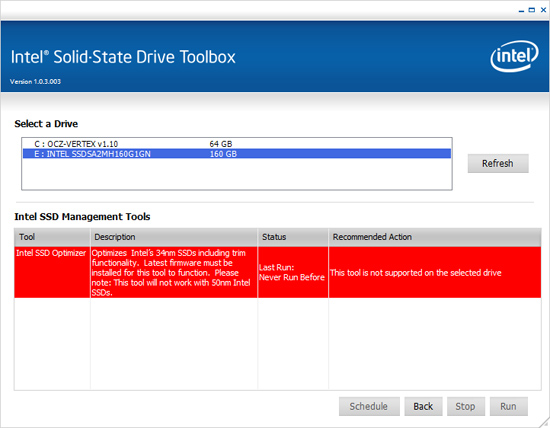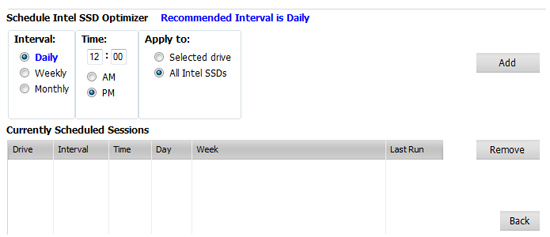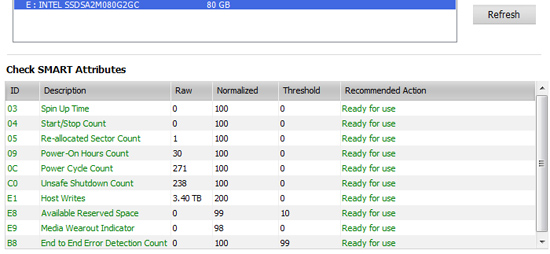The SSD Improv: Intel & Indilinx get TRIM, Kingston Brings Intel Down to $115
by Anand Lal Shimpi on November 17, 2009 7:00 PM EST- Posted in
- Storage
Wipe When You Can’t TRIM
There’s a major problem with TRIM today. The only Windows storage drivers to support it are written by Microsoft. The Intel Matrix Storage Manager (IMSM) driver will not pass the TRIM instruction to your SSD. This means you can't use anything but the drivers that ship with Windows 7. To make matters worse, if you enable non-member RAID on an Intel motherboard the default Windows 7 driver is an older version of IMSM so TRIM won't work there either - even if you don't have a RAID array created. Your best bet is to install Windows 7 with your I/O controller in AHCI mode (for Intel chipsets) and don't install any storage drivers. Intel is working on an updated IMSM that will pass the TRIM instruction to SSDs but it won't be ready for at least a couple of months.
TRIM won't work on a RAID array.
If you want to use IMSM or if you're using Windows XP or Vista, both of which do not support TRIM, there's another option. Earlier this year Indilinx released its Wiper Tool that performs a manual TRIM on their SSDs. It works by asking the OS for a list of the free space addresses on the partition and then sending the list with instructions to TRIM down to the SSD.

The Indilinx Wiper Tool
Today Intel introduces its own manual TRIM tool as a part of the SSD Toolbox:

On any Windows OS (XP, Vista or 7) regardless of what driver you have installed, Intel's SSD Toolbox will allow you to manually TRIM your drive. Intel calls it the SSD Optimizer, which of course only works on 34nm Intel SSDs (X25-M G1 owners are out of luck unfortunately).

The Intel SSD Optimizer lets you schedule the manual TRIM operation automatically
The SSD Toolbox also gives you access to SMART and drive health data, including telling you how many writes you've performed on your SSD, and what your current flash wear level is:

Running Intel's SSD Optimizer does work as advertised. I ran the PCMark HDD suite on a clean X25-M, once more on a drive that had been well used and once more after running the SSD Optimizer:
| PCMark Vantage HDD Score | Clean Run | Used Run | After SSD Optimizer |
| Intel X25-M G2 160GB | 35909 | 30354 | 34014 |
Intel's SSD Optimizer should be able to restore performance to about 95%+ of new, in this case it manages 94.7% - close enough.
Moving On: Forget About Invalid Data and Worry About Free Space
The existence of TRIM changes the way we test, something I alluded to in the SSD Relapse. Thankfully, we come prepared.
In previous articles we had to test SSDs in two conditions: new and used. The new state is just after a secure erase, the used state required us to write data to every user accessible portion of the drive first before benchmarking. The former resulted in great performance, the latter meant the SSD had to do a lot of juggling of existing data whenever it went to write. The second scenario no longer exists with TRIM. The act of formatting your drive or deleting files (and emptying the recycle bin) will TRIM invalid data.
Performance in a TRIM enabled system is now determined not by the number of invalid blocks on your SSD, but rather the amount of free space you have. I went into a deep explanation of the relationship between free space and the performance of some SSDs here.
TRIM will make sure that you don’t have to worry about your drive filling up with invalid data, but it doesn’t skirt the bigger issue: dynamic controllers see their performance improve with more free space.
My rule of thumb is to keep at least 20% free space on your drive, you can get by with less but performance tends to suffer. It doesn’t degrade by the same amount for all drives either. Some controllers are more opportunistic with free space (e.g. Intel), while others don’t seem to rely as much on free space for improved performance. Addressing performance degradation as drives fill up (with valid data) will be one of the next major advancements in SSD technology.










162 Comments
View All Comments
Celeus - Monday, November 9, 2009 - link
No comment regarding Anand, but the quote of $85 seems to be based on a press release from kingston.http://www.kingston.com/press/2009/flash/10c.asp">http://www.kingston.com/press/2009/flash/10c.asp
Now, I've been trying to find these for that price at Newegg, and can't. The drive now shows up (just the 2.5" one, not the one including the bracket) but for $124.99 before rebate $104.99 AR.
I bet this is an error they will fix, as $104.99 Before Rebate would make $84.99 AR, which is what Kingston mentions in their press release.
Rebate looks good for 2 per person, so I plan on buying two for a new Windows 7 box.
virtualgeek - Saturday, October 31, 2009 - link
Disclosure, I work for EMC (an enterprise information infrastructure - which includes all sorts of storage arrays).Looking at some of the comments, I'm not sure if people understand the impact of the x-25 getting down to the prices they are (both via kingston OEM and the 80/160GB drives).
Flash will rapidly replace all high-performance disk use cases. There will only be room for very large SATA and SAS disks, and all high performance use cases will be dominated by Flash.
Some people don't understand that even at TODAY's prices, for some (many) use cases (just not consumer focused ones), they are more economical. For example, the kingston drive, measured in IOPs/dollar is 37x **cheaper** than a 15K SAS drive. That's the acquisition cost. When you think that it would take 37 15K SAS disks, consuming more power, space and cooling - you can immediately imagine the impact this has on the enterprise storage market.
The rapid price decline we've all seen over the last year (a 40GB MLC drive cost ~$900 at the beginning of the year) means that in the next year or so, we'll have SSD with the $/GB of a large, fast rotating magnetic media disk, but still 100x better random IOps/$
While perhaps PCM non-volatile storage will eventually replace flash, that will happen well after flash replaces spinning media.
Great article Anand!
I did a post on it here...
http://virtualgeek.typepad.com/virtual_geek/2009/1...">http://virtualgeek.typepad.com/virtual_...ill-chan...
iwodo - Friday, October 30, 2009 - link
If V Series stays at $85, then making a Raid with 2 40GB V will be an VERY attractive option.So may be do a review on 2 40GB V series with Intel Software Raid? as well as other raid card?
excalibur3 - Thursday, October 29, 2009 - link
Thanks for the great article! I am just curious if the Kingston UltraDrives can use the same firmware update as intel and can be considered the same drive or if it is something like with OCZ and Super Talent in that they have separate firmware updates. Would the Kinston be a cheaper alternative to the Intel?Saturn1 - Thursday, October 29, 2009 - link
Is there a way to get the manual trim to run from the toolbox if you do not have that last firmware update?linster - Thursday, October 29, 2009 - link
Apparently Intel pulled the iso. Here's what you get after you click on the link,"02HA Firmware Upgrade for Windows 7* Systems - Unavailable
Intel has been contacted by users with issues with the 02HA firmware upgrade on Windows 7* systems and are investigating. We take all sightings and issues seriously and are working toward resolution. We have temporarily taken down the firmware update while we investigate.
Thank you for your patience."
Shadowmaster625 - Thursday, October 29, 2009 - link
Can you guys do some testing on the Runcore Pro IV 16GB PATA SSD? It supposedly uses the indilinx controller.coconutboy - Thursday, October 29, 2009 - link
Good article Anand, and I like the new tests you guys came up with. I have a request for a new type of test and I know others in the various hardware forums have these same questions.SSDs are too small for many of us to use as the lone drive in our system, and we thus have to combine an SSD as an OS/app drive w/ a traditional hdd for our file storage. Given that this is a reality for many of us eager to jump into SSDs, it'd be great if we could see a test that demonstrates a real-world scenario of users loading DBs/pictures/videos etc from our storage drive while still running our apps/OS from the ssd.
I know it's probably not something you guys could do regularly because the amount of testing would be a huge burden, but perhaps you fellas could do a one-off article just to highlight the differences? Maybe show a couple different usage scenarios such as:
~ a budget/midrange P55 setup w/ OS/apps on a small Indilinx ssd and a single 1TB drive for storage
~ an older Core 2/AMD system with the new Kingston offering used for OS/apps and the storage drives being pair of 640GBs in RAID 1.
I think this kind of article would be very useful to your readers and I know there's lots of us in various forums who are hesitant to jump into a hybrid ssd/hdd setup because we're unsure of exactly how it will affect us.
coconutboy - Thursday, October 29, 2009 - link
Still not a lot of info out there showing real-world usage scenarios w/ an ssd as the os/app drive and a regular 7200rpm or two as storage, but perhaps for others interested in this kinda testing something like this will suffice. From the MSI p55-gd65 review-http://www.anandtech.com/mb/showdoc.aspx?i=3655&am...">http://www.anandtech.com/mb/showdoc.aspx?i=3655&am...
krumme - Wednesday, October 28, 2009 - link
How about this collection:http://www.anandtech.com/storage/showdoc.aspx?i=34...">http://www.anandtech.com/storage/showdoc.aspx?i=34...
It measures where the speed matters most (sorry can not get link to work)
Is the world that different today than 2009?
We need to se results balanced like this
I do get a feeling that the 2009 test suite is heavely favoring the g2 drives
It is plain and simple what takes time. Not iops, we need seconds. And seconds where you can feel it; fx. seconds for diferent types of filecopying, handling large files, working while making backup, working while having virus scan.
The g2 is way overhyped, the samsung way underrated
Reading the results you can have the impression the velociraptor doesnt work for desktop use
The need for trim is overhyped and having severe consequenses
And the results from defective and bad bios updates from indilinx and espec. Intel, was to be seen in advance.
Are we going to se some new benchmark suite when gfx lrb arives??
The end results. Ordinary desktop people having hdd for servers and gfx for research.
It doesnt make sense.
Some bad thought creap into my mind. Help me. Is the Intel marketing a problem, if you dont behave? :) - or did they just give you the random 4k engineering hammer?
Anand - we need another ssd article !!! :)
Take care